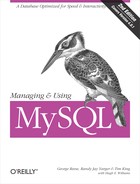Preface
Programmers have always put together software on their own time to “scratch their own itches.” Until the 1990s, however, programmers lacked distribution mediums for mass marketing their creations. The Internet changed that and gave life to grass-roots software distribution philosophies that have challenged those of the software giants. These philosophies include the Free Software and Open Software movements.
Though significant differences cause endless debate between the Free Software and Open Software camps, they share a core belief in the freedom to access and modify the source code of any legally licensed software. Though neither philosophy revolves directly around price, both have had the ultimate effect of reducing the cost of some traditionally high-cost software. The most famous example of this effect is, of course, the Linux operating system.
Database software has always been notoriously overpriced. The entire fortune of Oracle is largely founded on a single product—the Oracle database engine. Consequently, only large corporations have had the financial resources to leverage the power of relational databases. While database vendors struggled with how to license their software on the Internet, however, several groups of people were busy developing free and low-cost database solutions based on Free and Open Software philosophies. Our focus is one of these databases: MySQL.
MySQL is powerful and flexible, while at the same time lightweight and efficient. It packs a large feature set into a very small, fast engine. While it does not have anywhere near the full feature set of expensive corporate databases, it easily offers enough to meet the needs of mid-range database management.
